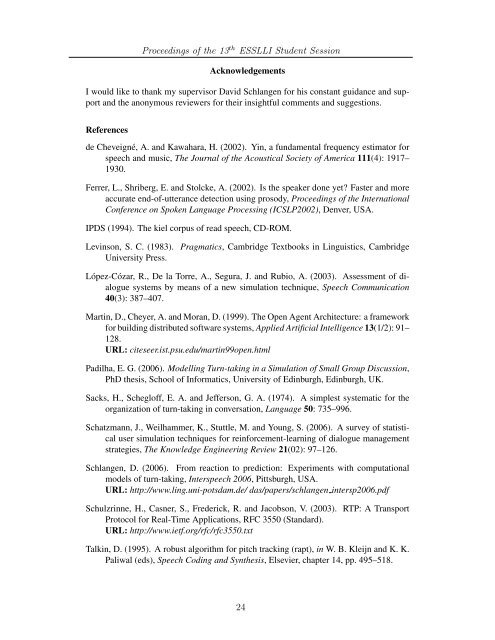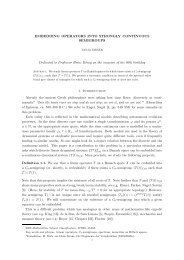Proceedings of the 13 ESSLLI Student Session - Multiple Choices ...
Proceedings of the 13 ESSLLI Student Session - Multiple Choices ...
Proceedings of the 13 ESSLLI Student Session - Multiple Choices ...
You also want an ePaper? Increase the reach of your titles
YUMPU automatically turns print PDFs into web optimized ePapers that Google loves.
Acknowledgements<br />
I would like to thank my supervisor David Schlangen for his constant guidance and support<br />
and <strong>the</strong> anonymous reviewers for <strong>the</strong>ir insightful comments and suggestions.<br />
References<br />
<strong>Proceedings</strong> <strong>of</strong> <strong>the</strong> <strong>13</strong> th <strong>ESSLLI</strong> <strong>Student</strong> <strong>Session</strong><br />
de Cheveigné, A. and Kawahara, H. (2002). Yin, a fundamental frequency estimator for<br />
speech and music, The Journal <strong>of</strong> <strong>the</strong> Acoustical Society <strong>of</strong> America 111(4): 1917–<br />
1930.<br />
Ferrer, L., Shriberg, E. and Stolcke, A. (2002). Is <strong>the</strong> speaker done yet? Faster and more<br />
accurate end-<strong>of</strong>-utterance detection using prosody, <strong>Proceedings</strong> <strong>of</strong> <strong>the</strong> International<br />
Conference on Spoken Language Processing (ICSLP2002), Denver, USA.<br />
IPDS (1994). The kiel corpus <strong>of</strong> read speech, CD-ROM.<br />
Levinson, S. C. (1983). Pragmatics, Cambridge Textbooks in Linguistics, Cambridge<br />
University Press.<br />
López-Cózar, R., De la Torre, A., Segura, J. and Rubio, A. (2003). Assessment <strong>of</strong> dialogue<br />
systems by means <strong>of</strong> a new simulation technique, Speech Communication<br />
40(3): 387–407.<br />
Martin, D., Cheyer, A. and Moran, D. (1999). The Open Agent Architecture: a framework<br />
for building distributed s<strong>of</strong>tware systems, Applied Artificial Intelligence <strong>13</strong>(1/2): 91–<br />
128.<br />
URL: citeseer.ist.psu.edu/martin99open.html<br />
Padilha, E. G. (2006). Modelling Turn-taking in a Simulation <strong>of</strong> Small Group Discussion,<br />
PhD <strong>the</strong>sis, School <strong>of</strong> Informatics, University <strong>of</strong> Edinburgh, Edinburgh, UK.<br />
Sacks, H., Schegl<strong>of</strong>f, E. A. and Jefferson, G. A. (1974). A simplest systematic for <strong>the</strong><br />
organization <strong>of</strong> turn-taking in conversation, Language 50: 735–996.<br />
Schatzmann, J., Weilhammer, K., Stuttle, M. and Young, S. (2006). A survey <strong>of</strong> statistical<br />
user simulation techniques for reinforcement-learning <strong>of</strong> dialogue management<br />
strategies, The Knowledge Engineering Review 21(02): 97–126.<br />
Schlangen, D. (2006). From reaction to prediction: Experiments with computational<br />
models <strong>of</strong> turn-taking, Interspeech 2006, Pittsburgh, USA.<br />
URL: http://www.ling.uni-potsdam.de/ das/papers/schlangen intersp2006.pdf<br />
Schulzrinne, H., Casner, S., Frederick, R. and Jacobson, V. (2003). RTP: A Transport<br />
Protocol for Real-Time Applications, RFC 3550 (Standard).<br />
URL: http://www.ietf.org/rfc/rfc3550.txt<br />
Talkin, D. (1995). A robust algorithm for pitch tracking (rapt), in W. B. Kleijn and K. K.<br />
Paliwal (eds), Speech Coding and Syn<strong>the</strong>sis, Elsevier, chapter 14, pp. 495–518.<br />
24

















